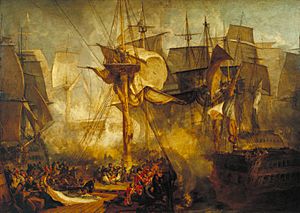Battle of Trafalgar facts for kids

The Battle of Trafalgar was a huge sea battle. It happened on October 21, 1805. The navies of France and Spain fought against Great Britain. The battle took place near Cape Trafalgar, which is a piece of land sticking out into the sea in southwest Spain. Britain won the battle very clearly. This victory helped Britain become the strongest sea power in the world for the next 100 years. The Battle of Trafalgar was the most important sea battle of the 19th century.
Before the Battle of Trafalgar
The Napoleonic Wars were happening at this time. France, led by Napoleon Bonaparte, had the strongest army in Europe. They controlled a lot of land. But Britain was an island. So, Britain had a very strong navy called the Royal Navy. They used their navy to blockade France. This meant they stopped French ships from leaving their ports.
Napoleon wanted to invade and take over Britain. To do this, he needed to defeat the British navy first. If he didn't, the British ships would stop his army from landing.
The British knew France might attack. They placed their ships outside important French ports, like Toulon. The main British admiral (a top navy leader) was Lord Horatio Nelson. He was famous in Britain for winning battles against the French, like the Battle of the Nile in 1798.
But the French navy managed to get away from Nelson's fleet during a storm. They then met up with some Spanish ships. Spain was a partner of France at that time. This group of ships first sailed to the West Indies. Then they sailed back across the Atlantic Ocean to the Spanish port of Cadiz. They wanted to join with more French ships to make an even bigger fleet. The British chased them all the way across the ocean and back.
The Battle Begins
The French then heard that some British ships were seen in Gibraltar. They thought this meant the British fleet was not as strong as before. So, they decided it was the best time to leave Cadiz.
The next day, 33 ships from France and Spain met 27 British ships. Admiral Nelson put his ships into two long lines. Just before the fighting started, he sent a famous message. It said: England expects that every man will do his duty.
The two British lines sailed right through the French and Spanish line. This split their enemy's ships apart. The British ships then caused a lot of damage to the French and Spanish ships using their powerful cannons.
However, Admiral Nelson was on his ship, HMS Victory. He was hit by a musket bullet fired by a sniper from a French ship. The bullet went into his shoulder and lung, and got stuck in his spine. He was taken below the deck. Nelson died later, around 4:30 pm, as the battle was ending. The French and Spanish lost 22 ships. The British did not lose any ships at all.
After the Battle
Because France could not invade Britain, British soldiers were able to fight on the European continent. They joined with armies from other countries against Napoleon's forces. In the end, Napoleon was finally defeated in 1815 at the Battle of Waterloo.
With control of the seas, Britain was able to build a large empire in the years that followed. Its navy remained the world's largest for over a hundred years.
Nelson's body was brought back to Great Britain. He was given a hero's funeral. In 1843, the famous Trafalgar Square and Nelson's Column were built in London. These were built to honor him and his great victory.
Images for kids
-
The Battle of Trafalgar painted by Clarkson Stanfield in 1836
-
Nelson's signal, "England expects that every man will do his duty", flying from Victory on the bicentenary of the Battle of Trafalgar
-
Artist's conception of HMS Sandwich fighting the French flagship Bucentaure (completely dismasted) at Trafalgar. Bucentaure is also fighting HMS Temeraire (on the left) and being fired into by HMS Victory (behind her). In fact, this is a mistake by Auguste Mayer, the painter; HMS Sandwich never fought at Trafalgar.
-
Painting depicting the French frigate Thémis towing the re-taken Spanish first-rate ship of the line Santa Ana into Cádiz. Auguste Mayer, 19th century.
-
Nelson on top of Nelson's Column in Trafalgar Square in London
-
The Battle of Trafalgar by J. M. W. Turner (oil on canvas, 1822–1824) combines events from several moments during the battle
-
Vice Admiral Horatio, Lord Nelson, by Lemuel Francis Abbott
-
Vice Admiral Cuthbert Collingwood
-
Pierre-Charles Villeneuve, the French Admiral
-
Federico Gravina, the Spanish Admiral
See also
 In Spanish: Batalla de Trafalgar para niños
In Spanish: Batalla de Trafalgar para niños

















